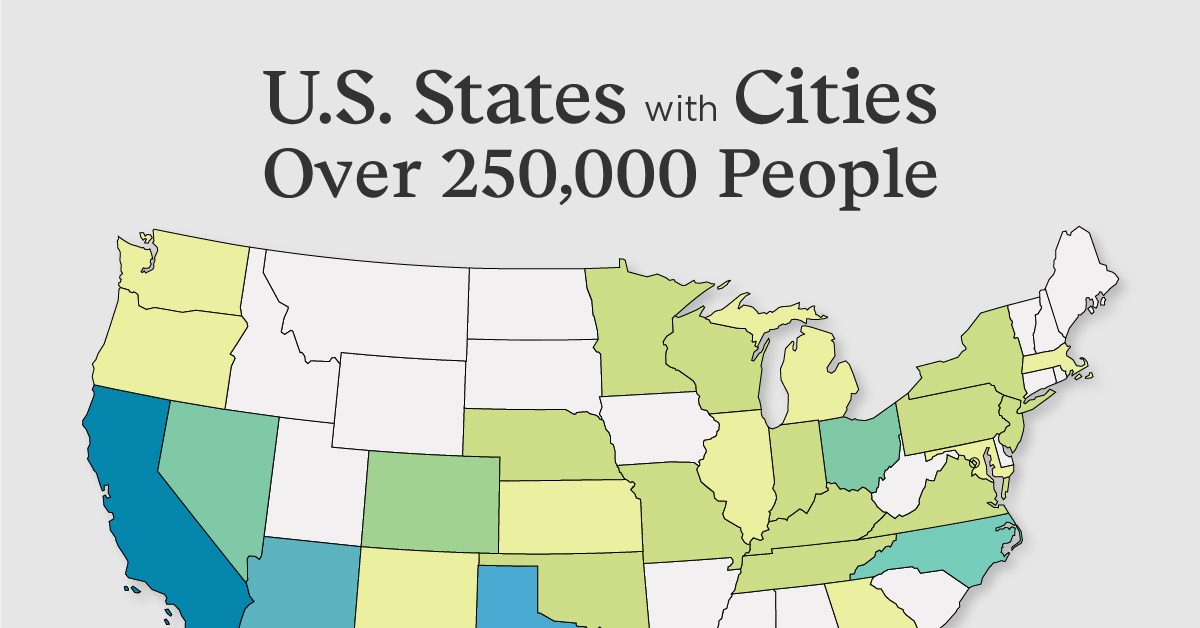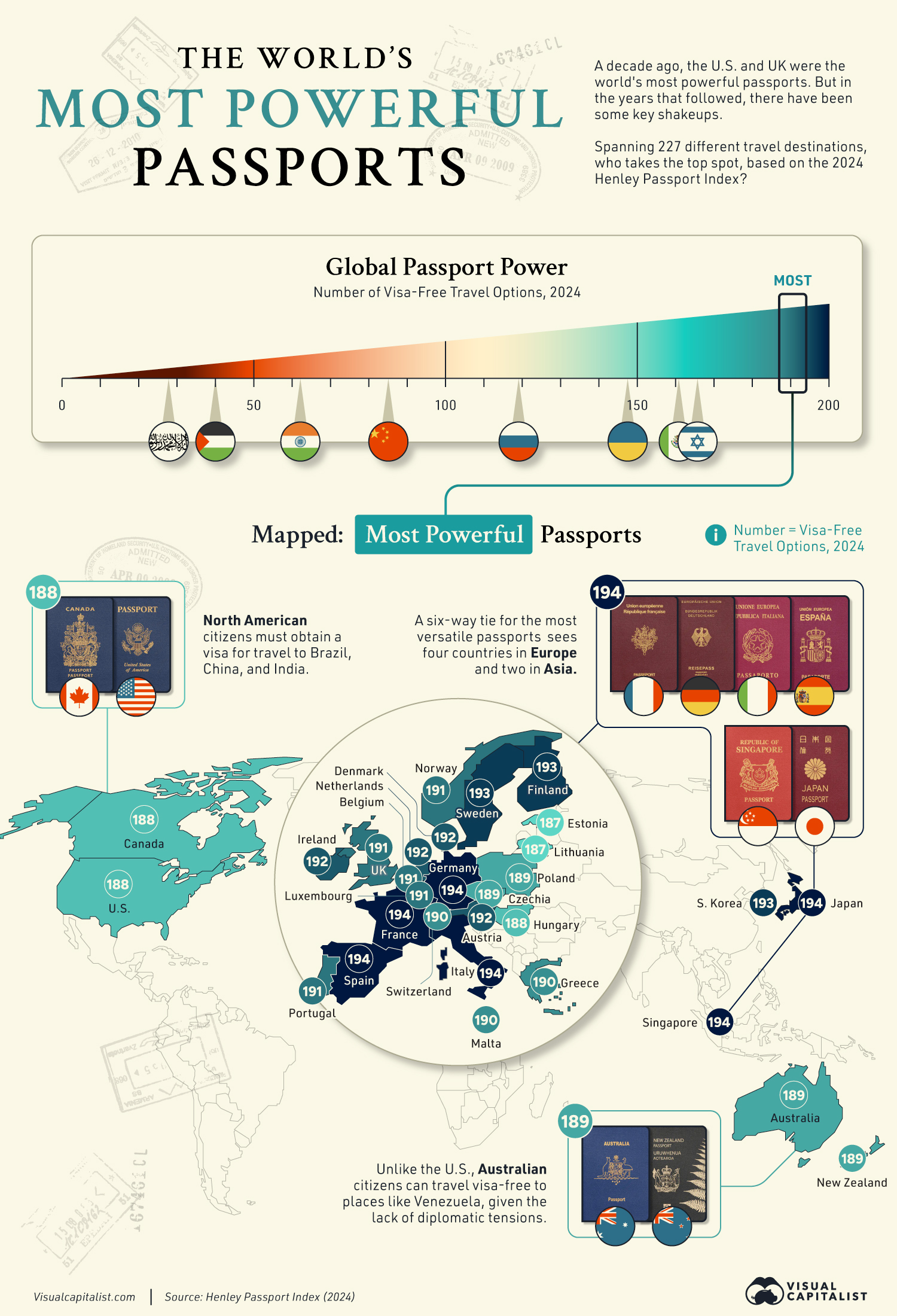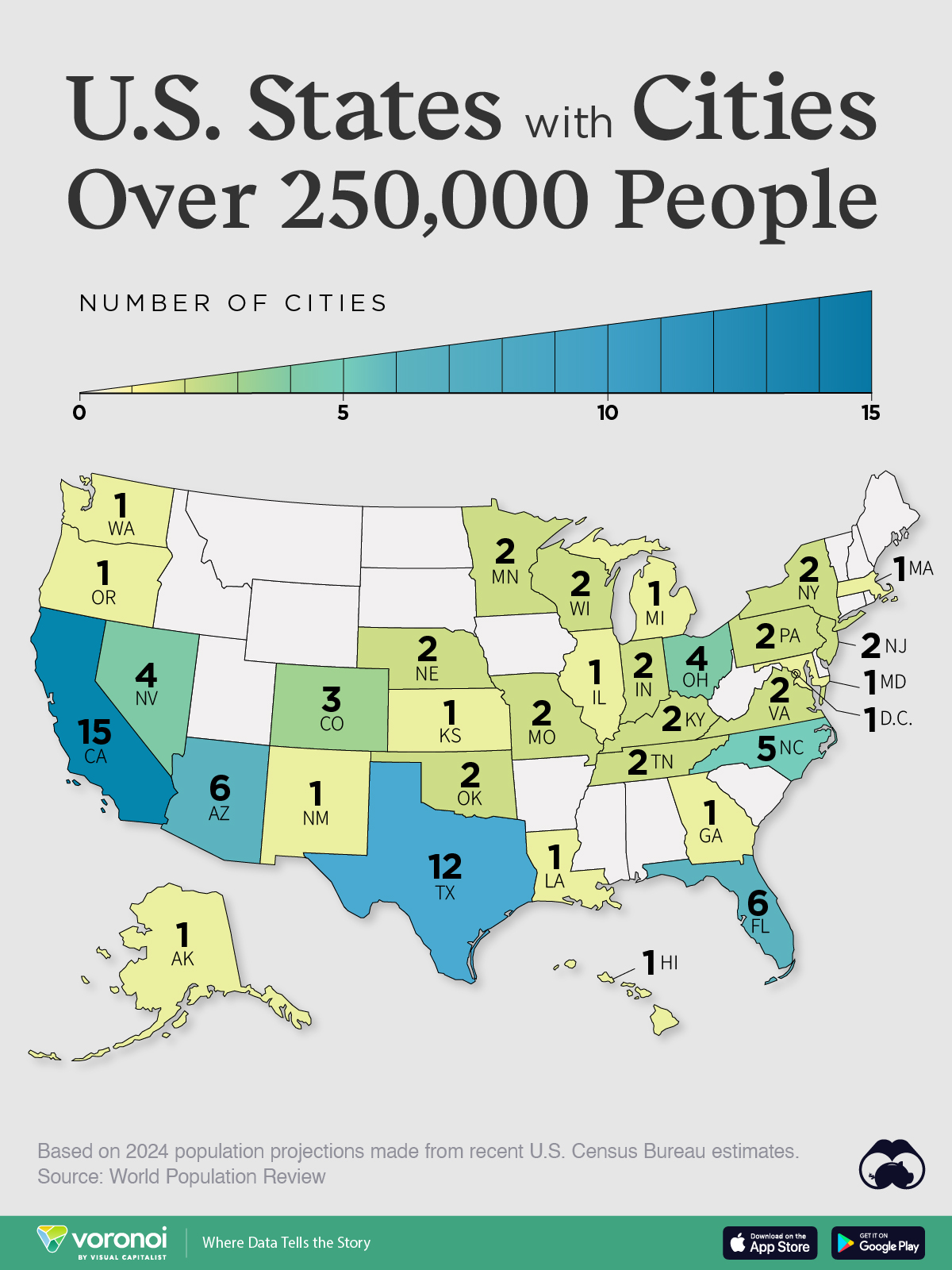Maps
The World’s Most Powerful Passports in 2024
![]() See this visualization first on the Voronoi app.
See this visualization first on the Voronoi app.
The World’s Most Powerful Passports in 2024
This was originally posted on our Voronoi app. Download the app for free on iOS or Android and discover incredible data-driven charts from a variety of trusted sources.
People around the world enjoy significantly greater travel freedom than they did just a couple decades ago.
In 2006, people could travel visa-free to 58 countries on average, while today that number has jumped to 111 destinations. Even in the last year, French, German, Spanish, and Italian citizens can now travel visa-free to three new countries.
This graphic shows the most powerful passports in 2024, with data from the annual Henley & Partners Passport Index.
Passport Strength in 2024
The world’s top passport is shared in a six-way tie, with visa-free access to 194 countries.
| Ranking | Country | Number of Countries with Visa-Free Access |
|---|---|---|
| 1 | 🇫🇷 France | 194 |
| 1 | 🇩🇪 Germany | 194 |
| 1 | 🇮🇹 Italy | 194 |
| 1 | 🇯🇵 Japan | 194 |
| 1 | 🇸🇬 Singapore | 194 |
| 1 | 🇪🇸 Spain | 194 |
| 2 | 🇫🇮 Finland | 193 |
| 2 | 🇰🇷 South Korea | 193 |
| 2 | 🇸🇪 Sweden | 193 |
| 3 | 🇦🇹 Austria | 192 |
| 3 | 🇩🇰 Denmark | 192 |
| 3 | 🇮🇪 Ireland | 192 |
| 3 | 🇳🇱 Netherlands | 192 |
| 4 | 🇧🇪 Belgium | 191 |
| 4 | 🇱🇺 Luxembourg | 191 |
| 4 | 🇳🇴 Norway | 191 |
| 4 | 🇵🇹 Portugal | 191 |
| 4 | 🇬🇧 UK | 191 |
| 5 | 🇬🇷 Greece | 190 |
| 5 | 🇲🇹 Malta | 190 |
| 5 | 🇨🇭 Switzerland | 190 |
| 6 | 🇦🇺 Australia | 189 |
| 6 | 🇨🇿 Czechia | 189 |
| 6 | 🇳🇿 New Zealand | 189 |
| 6 | 🇵🇱 Poland | 189 |
| 7 | 🇨🇦 Canada | 188 |
| 7 | 🇭🇺 Hungary | 188 |
| 7 | 🇺🇸 U.S. | 188 |
| 8 | 🇪🇪 Estonia | 187 |
| 8 | 🇱🇹 Lithuania | 187 |
While Japan and Singapore ranked first for the last five years, four European countries—France, Germany, Italy, and Spain— climbed the ranks this year.
This comes as China granted visa-free access to these European countries and 50 other nations in efforts to revive tourism in a post-pandemic era. This follows a broader trend of countries waiving visas to encourage travel and boost economic activity. In the last eight years, for instance, both Germany and Singapore were granted visa-free travel to 35 new countries.
Finland, Sweden, and South Korea tie for second place in the rankings. In fact, the latter country has one of the highest numbers of visa waiver agreements in the world.
The U.S. ranks in seventh, one of its worst relative rankings ever. Over the last decade, its standing has fallen in rank given diplomatic tensions and its relative lack of openness to foreign tourists. For example, Brazil recently removed visa-free access to U.S. citizens for reciprocity reasons—the U.S. requires Brazilians to have a visa to travel to the country.
From a regional perspective, 23 of the top 30 passports are in Europe and the UK, three are in Asia, while two are in both North America and Oceania.
Changes Ahead
After many years in the works, U.S. travelers will need a visa to travel to Europe in 2025.
In most cases, applications should be processed in minutes, but some may take as long as a few weeks. Travelers in Canada, Mexico, and South America will also be required to fill out the application. The good news is that the visa will be valid for three years or the date a passport expires, depending on which one happens first.
By contrast, Indonesia is discussing allowing visa-free access to 20 countries to encourage tourism and investment in the country. It is the second Asian nation after Singapore that is eyeing visa waivers to China. Recently, Thailand and Malaysia have provided the world’s second-largest economy visa-free access thanks to its role as a key driver of tourism in these countries.
United States
Mapped: U.S. States By Number of Cities Over 250,000 Residents
Eighteen U.S. States don’t have a single incorporated area with more than 250,000 people.

Mapped: U.S. States By Number of Cities Over 250K Residents
This was originally posted on our Voronoi app. Download the app for free on iOS or Android and discover incredible data-driven charts from a variety of trusted sources.
Over 80% of the American population lives in an “urban area” according to the U.S. Census Bureau. But where are all of the country’s largest cities, and what patterns can we see from their state locations?
This map shows U.S. states by their number of incorporated areas (i.e. cities or towns) that have more than 250,000 residents. Data for this map comes from 2024 estimates made by World Population Review, which were based on the latest U.S. Census Bureau figures.
Ranked: U.S. States By Number of Cities Over 250K Residents
California and Texas—also the most populous U.S. states—each have more than 10 cities with at least a quarter of a million inhabitants.
| State | Cities With 250K People | City Names |
|---|---|---|
| California | 15 | Los Angeles, San Diego, San Jose, San Francisco, Fresno, Sacramento, Long Beach, Oakland, Bakersfield, Anaheim, Riverside, Stockton, Irvine, Santa Ana, Chula Visa |
| Texas | 12 | Houston, San Antonio, Dallas, Fort Worth, Austin, El Paso, Arlington, Corpus Christi, Plano, Lubbock, Laredo, Irving |
| Arizona | 6 | Phoenix, Tucson, Mesa, Chandler, Gilbert, Glendale |
| Florida | 6 | Jacksonville, Miami, Tampa, Orlando, St. Petersburg, Port St. Lucie |
| North Carolina | 5 | Charlotte, Raleigh, Greensboro, Durham, Winston-Salem |
| Ohio | 4 | Columbus, Cleveland, Cincinnati, Toledo |
| Nevada | 4 | Las Vegas, Henderson, North Las Vegas, Reno |
| Colorado | 3 | Denver, Colorado Springs, Aurora |
| Tennessee | 2 | Nashville, Memphis |
| New York | 2 | New York, Buffalo |
| Pennsylvania | 2 | Philadelphia, Pittsburgh |
| Indiana | 2 | Indianapolis, Fort Wayne |
| Oklahoma | 2 | Oklahoma City, Tulsa |
| Kentucky | 2 | Louisville/Jefferson County, Lexington |
| Wisconsin | 2 | Milwaukee, Madison |
| Missouri | 2 | Kansas City, St. Louis |
| Nebraska | 2 | Omaha, Lincoln |
| Virginia | 2 | Virginia Beach, Chesapeake |
| Minnesota | 2 | Minneapolis, St. Paul |
| New Jersey | 2 | Newark, Jersey City |
| Illinois | 1 | Chicago |
| Washington | 1 | Seattle |
| District of Columbia | 1 | Washington D.C. |
| Massachusetts | 1 | Boston |
| Oregon | 1 | Portland |
| Michigan | 1 | Detroit |
| New Mexico | 1 | Albuquerque |
| Maryland | 1 | Baltimore |
| Georgia | 1 | Atlanta |
| Kansas | 1 | Wichita |
| Louisiana | 1 | New Orleans |
| Hawaii | 1 | Honolulu |
| Alaska | 1 | Anchorage |
Two other warm weather states, Arizona and Florida, also have a number of cities with 250,000 or more residents, at six each.
Eighteen U.S. states in total—including South Carolina, Alabama, and Utah to name a few—have no single incorporated area with 250,000 or more residents.
Cities, Towns, and Metro Areas
Like with all population data, definitions tend to play a big role in what is considered a city. In general parlance, built-up population centers are often thought of cities. However, an urban area can have a relatively big population and be incorporated as a town, as in the case of Gilbert, Arizona, which is included in the above map.
Separately, a collection of incorporated villages can be collectively referred to as a town, such as in the case of Hempstead, New York. Hempstead is an incorporated village with only 60,000 people, however it also lends its name to the wider town (an amalgamation of 22 villages and 38 hamlets) which has nearly 800,000 inhabitants. Three other New York towns listed below thus do not make the map for similar reasons.
| Town | State | Population |
|---|---|---|
| Hempstead | New York | 779,916 |
| Brookhaven | New York | 483,351 |
| Islip | New York | 333,322 |
| Oyster Bay | New York | 293,812 |
Source: World Population Review.
On the other hand, major hubs like Los Angeles often have a central city and surrounding suburbs, which are their own distinct incorporated cities as well. These are often counted as one major metropolitan region, but are still, technically separate cities. This leads to interesting results in the final count.
For example, in Arizona’s case, five of the six cities listed all belong to the greater Phoenix Metropolitan region.
Meanwhile, Nevada has two main population centers: Las Vegas and Reno. However two of Las Vegas’ suburbs, Henderson and North Las Vegas, are separately incorporated, and each have populations that crack the 250,000 mark.
Conversely, in South Carolina, there are no cities listed, despite having a state population of 5.3 million. The state’s urban areas are divided up in such a way that none of them (including the central cities of Charleston, Columbia, and Greenville) end up passing 250,000 in population.
-

 Markets1 week ago
Markets1 week agoMapped: The Most Valuable Company in Each Southeast Asian Country
-

 Personal Finance6 days ago
Personal Finance6 days agoVisualizing the Tax Burden of Every U.S. State
-

 Mining7 days ago
Mining7 days agoWhere the World’s Aluminum is Smelted, by Country
-

 Technology1 week ago
Technology1 week agoCountries With the Highest Rates of Crypto Ownership
-

 Money1 week ago
Money1 week agoCharted: What Frustrates Americans About the Tax System
-

 Economy1 week ago
Economy1 week agoMapped: Europe’s GDP Per Capita, by Country
-

 Stocks1 week ago
Stocks1 week agoThe Growth of a $1,000 Equity Investment, by Stock Market
-

 Healthcare1 week ago
Healthcare1 week agoLife Expectancy by Region (1950-2050F)














